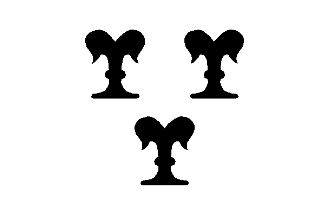
Last modified: 2018-12-15 by rob raeside
Keywords: lingewaard | bemmel |
Links: FOTW homepage |
search |
disclaimer and copyright |
write us |
mirrors
![[Lingewaard flag]](../images/n/nl-ge-ld.gif) image by Stefan Lambrechts, 28 Jun 2005, of http://www.flagchart.net
.
image by Stefan Lambrechts, 28 Jun 2005, of http://www.flagchart.net
.
I just got word from the municipality of Lingewaard, in Gelderland province,
about its new flag: white with the municipal logo.
The logo can be seen at the municipal
website, where it is explained as a multicolored butterfly, consisting
of 7 parts, each representing a village. (there is no explanation why only
part of the logo has been used on the flag).
The butterfly also symbolizes the rural environment of this municipality
in the Betuwe region, just north of Nijmegen.
The flag has been used recently in preparations for the "Nijmeegse
Vierdaagse", (walking event), where millions of astonished TV-watchers
will witness the guilds' prowess in municipal flag-throwing.
The flag was probably adopted at the same time as the logo: 1 Jan 2003.
This municipality was formed on 1 Jan 2001 by the merger of the former
municipalities of Bemmel, Gendt, and Huissen; at first it was named either
Bemmel or Betuwestad, renamed Lingewaard on 1 Jan 2003.
Stefan Lambrechts, 28 Jun 2005,
![[Lingewaard Coat of Arms]](../images/n/nl-ge)ld.jpg) image from the Lingewaard municipal
website.
image from the Lingewaard municipal
website.
Granted ? The High Council of Nobility has it under consideration. The Arms consist of the the elements and colors of the former municipalities.
 image from Shipmate Flagchart : http://www.flagchart.net
image from Shipmate Flagchart : http://www.flagchart.net
Bemmel was a municipality just south of Arnhem, which on 1 January 2001
became part of the new municipality of Lingewaard. It consisted of the
settlements Bemmel (seat), Haalderen, Heuvel, Baal, Bergerden, Houtakker,
Buitrendijks (Buitendijkse Waarde), Angeren, Doornenburg, Honderd Morgen,
Ressen en Doornik, and c. 12.000 inhabitants.
The flag was adopted 2 June 1961 and derived from the municipal Coat of Arms.
The rooks are also named 'bemmels', of which the origins seem to
lie in very early historic symbols.
Jarig Bakker, 10 Sep 1999
![[Doornenburg village flag]](../images/n/nl-ge_db.gif) image by Stefan Lambrechts, 14 Oct 2009, of http://www.flagchart.net
.
image by Stefan Lambrechts, 14 Oct 2009, of http://www.flagchart.net
.
Doornenburg is a village in the municipality of Lingewaard, Gelderland
province. Until 1 January 2001 it was part of Bemmel. It is renowned because
of its castle, which was formerly the center of the Lordship of Doornenburg.
This castle was built in 1365 on much older foundations, restored in 1660
and after WWII. It contains a chamber with the armorials of many Gelderian
and Hollandish nobles. One of the last owners of Doornenburg, from the
house of Amstel van Mijnden, had paintings made of the famous flight of
Gijsbrecht van Amstel from Amsterdam.
See: Doornenburg
Castle.
There was an old Catholic church, the oldest Christian temple in this
area.
Flag: 3 horizontal stripes of white and red, proportioned (c.) 2-1-2;
in center the full arms of the Lordship Doornenburg.
The flag is an initiative of the Shooting Company Gijsbrecht van Aemstel
van Doornenburg en Honderdmorgen, Historische Kring Doornenburg and Kasteel
Doornenburg. It was presented on the day of the Village Fair, 21 September
2009, designed by the firm of Drukwerk ABC from Doornenburg.
Source: Doornenburg
on line.
Jarig Bakker, 15 Oct 2009